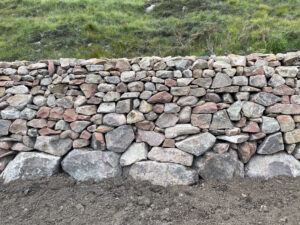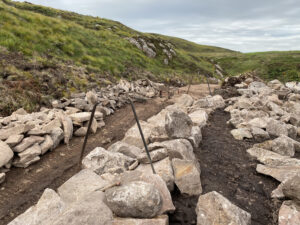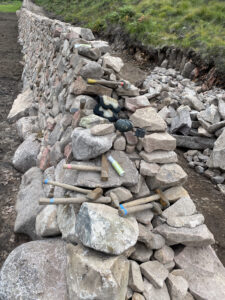
Over the course of the last 4 years, I have worked stints on the island of Tanera Mòr in the Summer Isles of Scotland, most recently this past August. While working here I have tried my hand at the traditional craft of drystone dyking and to a lesser standard, thatching heather. I have been particularly fascinated by drystone dyks since spending some time learning and building some for myself with extremely skilled drystone dykers.
I have gathered here some of the research that I have done into drystone dykes and below written down some general thoughts, questions and ideas that I have had off the back of my primary (learning and partaking in the process itself) and secondary (online and in books) research.
This year I intend to use my experiences of the process as the catalyst for my work.
Dry stone
- Stone walls found estimated to be from as early as 3500 BC.
- Cornish hedges (earth not stone) believed to date from 5000 BC (Guild of Cornish Hedges.)
- Global occurrence (Europe, North America, South America).
- Style is dependent on the available and naturally occurring stone.
- Older walls often constructed from stones and boulders cleared from fields in preparation for agriculture.
 Techniques:
Techniques:
-
- “Double” wall – This is the technique that I have begun learning.
- Placing two rows of stones along boundary to be walled.
- Flattish
 stones, diminishing in size as wall rises.
stones, diminishing in size as wall rises. - Smaller stones used as “chocks” for where the stones are more rounded, filling in the spaces.
- At intervals, “through stones” thread the back and front wall.
- Large and flat “cap stones” or “copes” are placed on top to further bond the wall.
- Holes in the wall – smaller are called “Bolt Holes” (no bigger than 8”) – larger are called “Cripple Hole” (between 8” and 24”) – “Sheep Creep”
- Galloway Dykes – No experience of building a wall like this.
- Double wall of larger boulders with single-wall on top
- Rickety appearance which deters livestock and people from climbing – a wall as a barrier as well as a repellent. Offensiveness of a wall, almost psychological.
- Holes (from ricketiness) allow for wind to pass through
- “Double” wall – This is the technique that I have begun learning.
-
- Minor variations can identify an area
- Technique can be used for buildings, fortifications, bridges
- Andy Goldsworthy
- Hanging Trees project
- Tension between a forested landscape and one which is farmed. ‘A field, cleared of trees, is the site of a battlefield that has occurred between a farmer and the land.’
- Storm King Wall
- DSW snaking through woods continues into a nearby pond and emerges the other side
- Hanging Trees project
General thoughts, questions and ideas:
- Walls…
- Defend
- Conceal
- Contain
- Deter
- Locate (varying styles in different areas)
- Marking (a cairn at the top of the mountain)
- Advent of wire fences means it is a dying craft – wire allows for far larger areas to be cordoned far quicker and far cheaper – what does this mean in the context of modern agriculture and thus on the impact of the environment? Stone walls last much longer
- The contrasts between traditional building techniques and contemporary ones in terms of the number of materials and processes required.
- The idea of a dyke being almost a universal harbinger of pastoral life and also of our collective human history.
- A timelessness, almost “cosy” feeling to the aesthetic of the walls.
- An evaluation of what the dykes are indicative of – as mentioned, a pastoral and historical connotation. They are also intensely political, perhaps more so now than ever – these types of walls would have been the early praxis for dividing up and distributing land hundreds if not thousands of years ago and these decisions, codified by the construction of barriers/borders such as drystone dykes still have huge impacts and relevance to the ways in which we live today.

